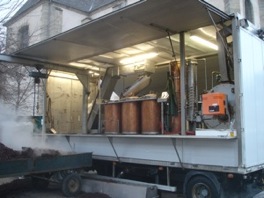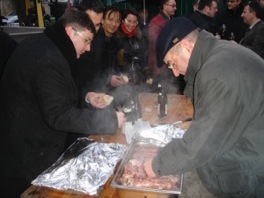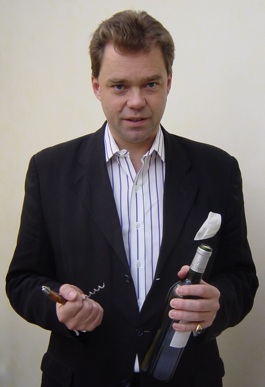Breakfast in Pommard


Above left, the trailer-mounted mobile distillery and, right, the bank manager dishes out the food.
One of the by-products of the winemaking process is a great quantity of skins, pips and stalks, called the marc (pronounced like the surname ‘Maher’) and, in this part of the world at least, it does not go to waste. It comes in the form of an almost-dry cake that is plum coloured and breaks easily to the touch. It also arrives by the truckload and on mornings such as this it is capped with a couple of inches of snowy ‘icing’. Then it is shovelled laboriously into a stainless steel hopper before being lifted by a small conveyor belt and deposited into one of the copper cylinders (which are like large versions of domestic hot water tanks). The tank is closed and then the sorcery begins… Steam is pumped into the bottom and as it rises through the marc it captures the residual alcohol and flavours that never made it into the wine. The liquid that comes off the top then goes through a condenser and soon after, through a small pipe at the far end of the trailer, a steady stream of clear, slightly viscous spirit pours: Marc de Bourgogne.
But the locals have not come to watch what, for them, is a routine annual event, and a clue to their intentions can be found on the back of another trailer parked close by. Here, the spent marc, steaming copiously, is deposited, 250 kilos at a time, as the cylinders are emptied after a process that lasts about 90 minutes. Through the steam can be seen two bright patches of silver kitchen foil covering, as it transpires, a couple of deep metal dishes laden with a variety of meats. These have been buried up to their ‘chins’ in the hot marc for an hour or more and now they are removed and taken to a side table where the bank manager assumes the role of carver-in-chief.
There are thick sausages, pork ribs and whole chickens and he has to fight for elbow-room as the crowd pushes forward enthusiastically. From the boulangerie comes an armful of baguettes and away to the side a purposeful gent is putting a corkscrew to good use. Glasses that have stood upside down on the table overnight are now rimmed with ice, so the first sip is taken with caution, but it is the first bite of baguette, bursting with sausage, that sticks in the memory. Warm juice runs down the chin and trickles onto the fingers but who cares? The meat is succulent and tasty and infused with fruit from the wine and spice from the spirit.
And the wine to accompany this carnivore’s delight? The white is a Bourgogne Chardonnay and the red is a Givry 2005, made by the distillateur, Eric Pigneret. Givry is one of the lesser-known villages in Burgundy but it has a solid reputation amongst insiders for producing good value wines that often punch above their weight. This is one of them and it is from the excellent 2005 vintage to boot. The brisk rasp of cherry fruit is just the right counterpoint to the fatty richness of the meat. Pigneret is obviously a man of many talents and his reputation as a distillateur sees him in demand in locations such as Maranges, Couchois and Puligny-Montrachet, as well as his three-week stint here in Pommard.
He is happy to talk about his 25 years in the business but then distraction arrives in the shape of a magnum of 1998 Pommard 1er cru and it is being poured by the winemaker himself, Olivier Cyrot-Buthiau. A gentle frisson ripples through the crowd and glasses are discreetly drained before being proffered for a sample. It is delicious, caught at the moment in its development when brash youth has given away to some maturity, with no sign of frailty as yet. The combination of bitter morning and frozen fingers paradoxically help rather than hinder the crowd’s appreciation of the wine. Context, as they say, is everything.
Cyrot-Buthiau is based in the heart of the village (opposite the boulangerie, since you asked) and, in a region where winemakers seldom give much thought to the ‘shop front’ side of their business, visiting here is a delight. Olivier’s wife, Fabienne, runs a small boutique selling interior furnishings and decorations, and the wines are for sale right beside them. Inevitably there is a quartet of Pommards, including a trio of premier crus, and a Volnay (the next door village). Less predictably there are also wines from the southernmost reaches of the Côte d’Or, Santenay and Maranges. This is where Olivier’s mother came from (she is the ‘Buthiau’ of his surname), which explains their presence in the range. He also makes a Cremant de Bourgogne, a sparkling Burgundy, and all the wines are characterised by some decent body and substance, without too much of the weight that sometimes can make Pommard hard going. Perfect for a meat-laden breakfast at the distillery, in fact.

